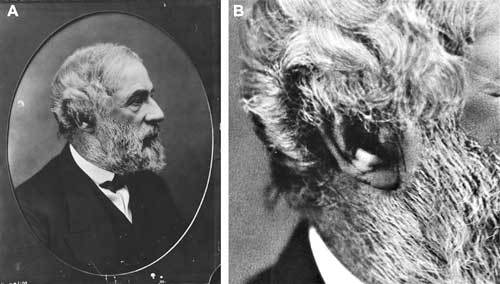Marc Abrahams's Blog, page 201
December 13, 2017
“Roxanne,” plus 5 percent compounded
The song “Roxanne,” by The Police, gets a five-percent speed boost every time the singers sing the word “Roxanne”, in this video:
Thanks to Mason Porter for bringing this to our attention.
BONUS: Earlier today, we reported a different experiment in data communications: “Data Communications via Wet Sting, or via Hungry Snail.”

Data Communications via Wet String, or via Hungry Snail
A wet string works, for sending information from one computer to another, says a new experiment. This adds to the list of low-tech ways to move data, the most lively method involving a hungry snail.
The string experiment is reported on the RevK’s Rants web site, with the headline “It’s official, ADSL works over wet string“:
Broadband services are a wonderful innovation of our time, using multiple frequency bands (hence the name) to carry signals over wires (usually copper, sometimes aluminium). One of the key aspects of the technology is its ability to adapt to the length and characteristics of the line on which it is deployed.
We have seen faults on broadband circuits that manifest as the system adapting to much lower speeds, this is a key factor as a service can work, but unusually slowly, over very bad lines.
It has always been said that ADSL will work over a bit of wet string. Well one of our techies (www.aa.net.uk) took it upon himself to try it today at the office, and well done. He got some proper string, and made it wet….
The snail breakthrough was reported here, in the Annals of Improbable Research, in 2005 (volume 11, no. 4), with the headline “Sluggish Data Transport Is Faster Than ADSL“:
We describe an experiment in which a Giant African Snail, acting as a data transfer agent, exceeded all known “last mile” communications technologies in terms of bit-per-second performance, adding to the many paradoxes of broadband communications.1 We discuss the unique motivational and guidance systems necessary to facilitate snail-based data transport, and observe with satisfaction that in a society that worships the fittest, fastest, and furtherest, the meek and the slow can….
(Thanks to Dominic Dunlop for bringing the wet string experiment to our attention.)

December 12, 2017
“Egg unboiling machine enables graphene battery development”
“Egg unboiling machine enables graphene battery development,” is the headline in Mining Weekly. The article itself says:
The Australian researchers who successfully unboiled an egg are turning their attention to capturing the energy of graphene oxide to make a more efficient alternative to lithium-ion batteries.
The Flinders University team in South Australia has partnered with Swinburne University of Technology in Victoria, ASX-listed First Graphene and manufacturer Kremford….
In 2015, Flinders University scientists were awarded an Ig Nobel Award for creating the Vortex Fluidic Device (VFD) and using it to unboil an egg. The device has also been used to accurately slice carbon nanotubes to an average length of 170 nanometres using only water, a solvent and a laser. It has also been used to process graphene to a high quality for commercial use.

The basic egg-unboiling technology is being used for many, seemingly unrelated things. Among those is the quick inexpensive production of drugs that were otherwise slow and expensive to produce.
Graphene is much in the news thanks to Andre Geim, who shared a Nobel Prize in 2010 for being the first to obtain and experiment with usable amounts of graphene, and who a decade earlier, in 2000, shared an Ig Nobel Prize for using magnets to levitate a frog.

December 11, 2017
Ping Pong Patches (traumatic accidents with table tennis balls)
Some sports related injuries are less common than others. For example, there is only one* formally documented case of ‘Ping Pong Patches’ (Scott MJ Jr, Scott MJ III, Cutis, 1989; 43 : 363 – 364.) in the medical literature. Sadly, the online database for Cutis only goes back as far as year 2000. But fortunately, the paper is cited in ‘Diagnosis of sports-related dermatoses’ (Andrei Metelitsa, Benjamin Barankin, MD, and Andrew N. Lin, MD, FRCPC, International Journal of Dermatology, 2004, 43, 113 –119).
“Ping-pong patches (Fig. 4) present as 12–15-mm circular lesions with erythematous or purpuric border and clear center. They are caused by high-velocity ping-pong balls striking the exposed or protected skin”
What can be done about them?
Treatment : “Warm compresses for 5 to 10 minutes two or three times per day may assuage the pain. Nonsteroidal antiinflammatory drugs may also be required, depending on the pain.”
Prevention : “Loose-fitting clothing may dampen the force of the ball, but welts may still develop beneath these clothes.”
See: Chapter 3, (sports-related traumatic conditions) of ‘Sports Dermatology’ (Ed. Brain B. Adams)
*Note: If you are aware of any other documented cases of ‘Ping pong Patches’ please let us know so that this article can be corrected.

December 10, 2017
Sleep to forget teacher, or sleep to remember grandmother?
It seems that a lack of sleep may prevent the brain from forgetting unimportant information. A lack of sleep may also prevent the brain from remembering important information. How can scientists make sense of this seemingly-nonsensical seeming-contradiction?
Imagine you just met your child’s teacher, who is named Gwen. The name Gwen, however, is firmly associated in your memory networks with your grandmother, who is also named Gwen.
Under such conditions, you may unintentionally think that your grandmother has no children, or that the teacher is in fact your grandmother. Researcher Gina Poe poses this example in the paper, “Sleep Is for Forgetting,” as well as a diagram of this example:
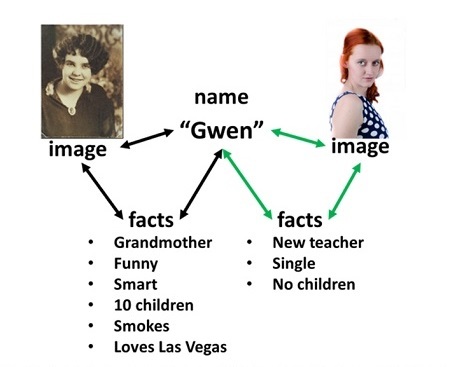
Figure 2: Disambiguating the teacher Gwen from the grandmother Gwen requires sleep-dependent consolidation of the novel information while protecting the grandmother schema.
Poe claims that when the brain is asleep, ‘garbage’ memories and links can be deleted. Hormones that activate during rest could protect long held memories from deletion, in this case protecting the grandmother from the new teacher. Sleep could prevent unintentional overlaps in memory, and socially problematic mix-ups.
Don’t forget to remember to read the companion paper by Susan Sara, “Sleep to Remember.” Sara reviews the literature, taking a dig at the ancient Greeks:
According to Aristotle, the sleep state was “a boarder-land between living and not-living: a person who is asleep would appear to be neither completely non-existent nor completely existent” (Sprague, 1977). Clearly, ancient Greek thought did not attribute any important functional role to the sleep state.
Sara’s article covers a history of studies suggesting that rapid eye movement (REM) sleep helps consolidate memories by making some connections stronger. More recent examples are used, as well as the early experiments of sleep depriving rats that “… involved constraining the animal on an inverted flower pot surrounded by a pool of water.”
Each researcher comments on the other’s paper, pointing out details that are seemingly-reasonable reasons for their analysis.

Dicey, and then some: Stirred, not shaken (physics)
“Dice Become Ordered When Stirred, Not Shaken” is a headline on a snappy summary of a new physics paper. The headline, and the summary, are published in Physics Focus. Their own summary of their summary: “A jumble of thousands of cubic dice, agitated by an oscillating rotation, can rapidly become completely ordered, a result that is hard to produce with more conventional shaking.”
The researchers produced an action video:
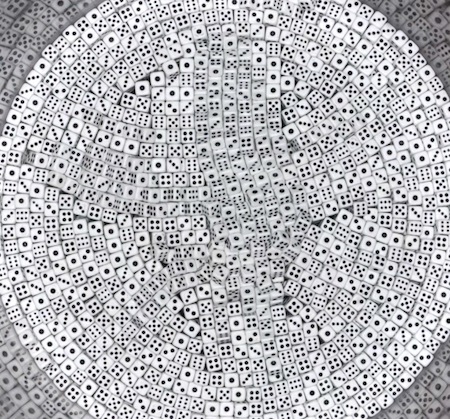
The study itself is “Experimental Study of Ordering of Hard Cubes by Shearing,” K. Asencio, M. Acevedo, I. Zuriguel, and D. Maza, Physical Review Letters, epub December 1, 2017. The authors, at Universidad de Navarra, Spain and Unidad Monterrey, Mexico report:
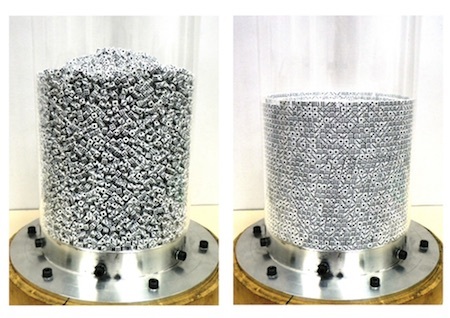 “We experimentally analyze the compaction dynamics of an ensemble of cubic particles submitted to a novel type of excitation. Instead of the standard tapping procedure used in granular materials we apply alternative twists to the cylindrical container. Under this agitation, the development of shear forces among the different layers of cubes leads to particle alignment. As a result, the packing fraction grows monotonically with the number of twists. If the intensity of the excitations is sufficiently large, an ordered final state is reached where the volume fraction is the densest possible compatible with the boundary condition.”
“We experimentally analyze the compaction dynamics of an ensemble of cubic particles submitted to a novel type of excitation. Instead of the standard tapping procedure used in granular materials we apply alternative twists to the cylindrical container. Under this agitation, the development of shear forces among the different layers of cubes leads to particle alignment. As a result, the packing fraction grows monotonically with the number of twists. If the intensity of the excitations is sufficiently large, an ordered final state is reached where the volume fraction is the densest possible compatible with the boundary condition.”
(Thanks to Mason Porter for bringing this to our attention.)

December 8, 2017
Modelling heat loss from a semi-spherical cow udder
Theoretical physicists are sometimes accused of making over-simplifications for mathematical models. This has lead to many variations on the spherical cow story, where a physicist claims to be able to cure a sick cow, but only if it is a spherical cow in a vacuum. Oddly, most iterations of this tale ignore heat radiated from a cow.
In a classic case of life semi imitating art, researchers Kifle Gebremedhin and Binxin Wu focus on heat radiated from only one part of a dairy cow in the paper titled “Modelling heat loss from the udder of a dairy cow.” Since they are using a semi cow, they decided to use a semi sphere to model the udder.
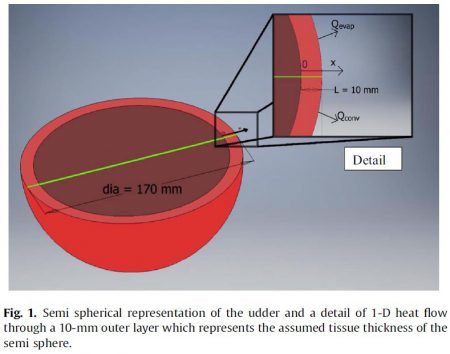
According to the researchers, it only takes ten assumptions to reduce a fully functioning, mooing, milk producing cow into a semi spherical udder model:
1. Cow udder is semi sphere.
2. Radius of the semi sphere is 0.17 m.
3. An outer layer of 10-mm thickness of tissue was assumed for
heat transfer between the udder and ambient air (Fig. 1).
4. A one-dimensional transient (a function of time) heat flow was
assumed through the thickness of the tissue (Fig. 1).
5. Heat lost from the udder skin surface when the cow is standing is by evaporation and convection.
6. Core temperature of udder tissue is 38.6°C.
7. Metabolic heat production rate in the tissue is 1946 W/m3.
8. Blood-flow time through the udder takes between 2 and 4 min.
9. The physical and thermal properties are assumed to be constant.
10.Temperature of blood entering the udder is equal to core temperature.
As noted here before, other models for determining heat loss from whole cows have been around for some time. Some models treated cows as cylinders, while others ignored cow geometry completely and used temperatures and humidity. This particular model is unique in that it simplifies the the cow to a single organ. But how was that organ selected?
Dairy cows are usually cooled off by spraying water from above to wet their bodies. Gebremedhin tried the inverted tactic of wetting the cows from below in “Alternative Cooling of Dairy Cows by udder Wetting,”
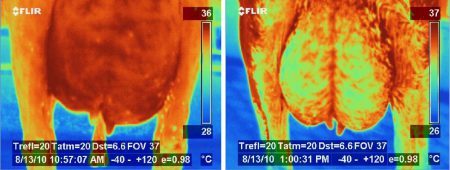
Thermal images of an udder before and after wetting.
Cooling the udder was just as effective as trying to cool off the entire body of the cow. Gebremedhin found that the massive amount of blood flowing through the udder likely distributes the cooling quickly.
The semi-spherical udder model paper shares the result:
… the udder could be considered as a heat sink, and thus, in time of heat stress, a dairy cow could be cooled by cooling the udder…

December 7, 2017
Cardinal Ludovico Trevisan’s earlobe crease (study)
Attention was recently drawn to the fact that Robert E. Lee had a crease in his right earlobe, and that he died from cardiovascular disease. But Lee was by no means the only historical figure who showed such signs.  Francesco M. Galassi, Dr. who is a Postdoc assistant in the Paleopathology and Mummy Studies Group at the University of Zurich, reminds us that there are abundant opportunities for paleopathological research in this area. He has recently discovered, for example, that Cardinal Ludovico Trevisan (1401–1465) [pictured] not only had a crease across his auricular lobe, but also :
Francesco M. Galassi, Dr. who is a Postdoc assistant in the Paleopathology and Mummy Studies Group at the University of Zurich, reminds us that there are abundant opportunities for paleopathological research in this area. He has recently discovered, for example, that Cardinal Ludovico Trevisan (1401–1465) [pictured] not only had a crease across his auricular lobe, but also :
“[…] the cardinal’s death, which occurred five to six years after the portrait was made, in Rome on 22nd March 1465, might very well have been the result of oedema, once known by the currently obsolete term ‘dropsy’, a common final pathophysiological step of several organ failures such as hepatic and renal, and well known to be associated with cardiovascular disease.”
See: Palaeopathology of the earlobe crease (Frank’s sign): New insights from Renaissance art, International Journal of Cardiology, Volume 236, 1 June 2017, Pages 82-84.
Bonus assignment [optional] List historical individuals (aside from Robert E. Lee and Cardinal Ludovico Trevisan) for whom there is existing visual evidence of earlobe creases and who are also recorded as having died as a result of cardiovascular problems.

December 6, 2017
A refreshing medical report about detox tea
A new medical paper says that one popular brand of what’s called “detox tea” is pretty tox. The study is called “Yogi Detox Tea: A Potential Cause of Acute Liver Failure.” It’s published in the journal Case Reports in Gastrointestinal Medicine.
The study’s authors, at Drexel University Hospital, in Philadelphia, say: “We present a case of acute fulminant liver failure from a liver detoxification tea. We present a 60-year-old female with weakness, lethargy, scleral icterus, jaundice, and worsening mental status. She drank herbal tea three times a day for 14 days prior to symptom development. Liver tests were elevated. Remaining laboratory tests and imaging were negative for other etiologies. An ultrasound-guided liver biopsy showed submassive necrosis. A literature search on the ingredients shows six ingredients as having hepatotoxic effects and remaining ingredients as having very sparse hepatoprotective data.”

December 4, 2017
The Right Earlobe Crease of Robert E. Lee (study)
The photo shows Robert E. Lee’s right earlobe crease (ELC) He died at the age of 63, on October 12th 1870, from the effects of coronary artery disease (CAD). The question arises – are the presence of the crease and the fact that he had severe cardiac problems related? Put another way, are ELCs (necessarily) a (reliable) sign of CAD?
For a particular set of answers, turn to The American Journal of Cardiology, Volume 120, Issue 2, 15 July 2017, Pages 327-330, where you will find the thesis : Robert E. Lee’s Right Ear and the Relation of Earlobe Crease to Coronary Artery Disease by Richard A.Reinhart MD.
Note: He does not appear to have had a prominent left earlobe crease [Discuss]
Further viewpoints: Earlobe Crease And Heart Disease: Is It Real? Review Of Evidence by Joe Cannon MS.

Marc Abrahams's Blog
- Marc Abrahams's profile
- 14 followers






